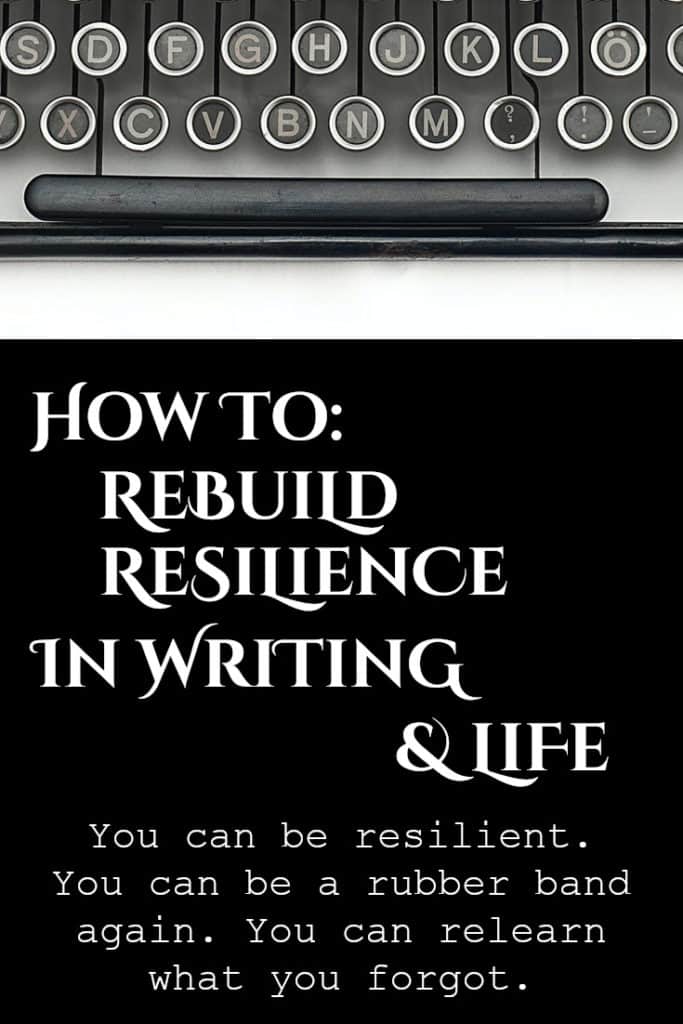How to: Rebuild Resilience in Writing & in Life
Psychologists and self-help gurus like to throw around the word resilience like a panacea: it’s supposed to be something like aloe—a natural salve that works and you don’t need to know why. I agree.
‘Nuff said? Of course not.
Resilience, as defined, is an ability to bounce back from difficulties, often emotional. Resilience is something that has to be rebuilt into a person because—believe it or not—as kids we were really good at it.
As adults, we fail.
Think of a rubber band for a moment.
It is elastic.
It is resilient.
Now, stick that rubber band in the sun for a few days and bake it.
Resilient?
The longer the rubber band is in the sun, the more brittle it becomes. When you try to pull on it after a few weeks, it will probably break.
That sun is like the tiny failures or the negative attitudes you face at work or as you sit down to write that novel. They bake your brain and turn your resilience into a brittle round thing of rubber. When a person pulls on it after a while, it’ll break.
When that one person say that one thing…. Boom! Fireworks!
With respect to human performance error precursors—those holes that lead to events—there are several ways a lack of resilience can have a major impact:
- Distractions/Interruptions
- Personality Conflicts
- Time Pressures (in a hurry)
- Irreversible Actions
- Unclear Goals, Roles, Responsibilities
- Lack of or Unclear Standards
- Stress
- Inaccurate Risk Perception
- Mental Shortcuts or Biases
- Imprecise Communication Habits
- Indistinct Problem-Solving Skills
- Unsafe Attitudes
- …and more!
There’s a bit of hope, however.
Building back the resilience you had as a kid takes time and effort. You can’t do it by snapping your fingers (or buying a new rubber band). You have to take it one step at a time.
Remember that resilience is that deep quality that allows some people to be kicked around by a cruel life and yet still come back like Rocky or Gumby or a hobbit. Resilient people won’t let failure overwhelm them and suck dry the marrow of their motivation.
So what are some of the factors that make a person resilient, that keep the rubber band elastic?
- A positive attitude
- Optimism
- The ability to regulate emotions
- The ability to see failure as a form of helpful feedback
You see, even after the means to the end—the instrumentality of an effort—fails, resilient people are blessed with an outlook that allows them to move forward in time and not focus on failure.
Simple to do, right?
Ha! If it was simple, well you probably wouldn’t see too many instances where that one person says that one thing….
So what if you’re not a resilient person? What can you do?
The American Psychological Association (APA) has listed a few tips to help you build resilience (with my notes added):
- Make connections (that whole “social networking” thing existed before Twitter and Facebook, you know)
- Help others (nothing feels better than that)
- Maintain a daily routine (do this, do that, repeat)
- Take a break (not for years…try it for a day or two and take a walk in the forest)
- Learn self-care (really, if you don’t feel good, you won’t want to bounce back)
- Move toward your goals (did you set a goal in the first place?)
- Nurture a positive self-view (you are good at what you do; how many people have your experiences?)
- Keep things in perspective and maintain a hopeful outlook (again, how many people have accomplished what you accomplished?)
- Look for opportunities for self-discovery (keep learning and learning about yourself)
- Accept that change is part of living (we know that, but there are many people who are resistance to change)
There is a lot of help out there to help you bounce back after failures.
You can be resilient. You can be a rubber band again. You can relearn what you forgot.
[subscribe2]



















